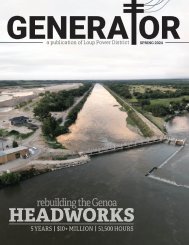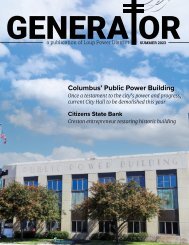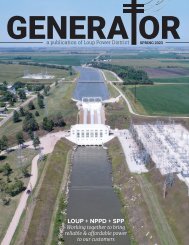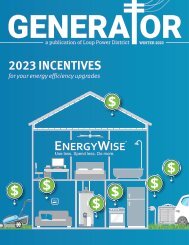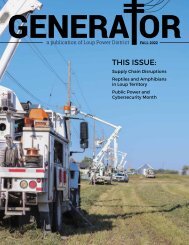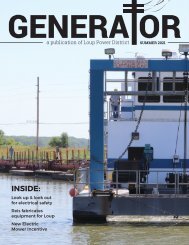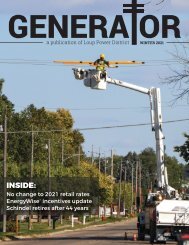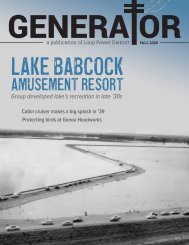Winter 2024 Generator
Topics in this issue include a 2024 rate increase, a lineman's perspective on the power restoration, and 2024 EnergyWise incentives.
Topics in this issue include a 2024 rate increase, a lineman's perspective on the power restoration, and 2024 EnergyWise incentives.
Create successful ePaper yourself
Turn your PDF publications into a flip-book with our unique Google optimized e-Paper software.
GENERA OR<br />
a publication of Loup Power District WINTER <strong>2024</strong><br />
Behind the Scenes:<br />
Power Restoration<br />
<strong>2024</strong> Retail Rates<br />
EnergyWise Incentives
BOARD OF DIRECTORS<br />
Bob Cerv<br />
Chairman<br />
Jim Donoghue<br />
First Vice Chairman<br />
Mike Fleming<br />
Second Vice Chairman<br />
Rich Aerni<br />
Secretary<br />
Dick Tooley<br />
Treasurer<br />
Alan Drozd<br />
Steve Heesacker<br />
Larry Zach<br />
HOW DO WE SET<br />
ELECTRICITY RATES?<br />
Loup Power District identifies electricity rates based on cost of service<br />
while keeping our customers and our communities front and center. As a<br />
not-for-profit company, Loup does not answer to remote shareholders and<br />
is not driven by a profit motive. Revenues are invested right back into the<br />
company and communities.<br />
EXECUTIVE STAFF<br />
Neal Suess<br />
President/CEO<br />
Walt Williams<br />
Vice President,<br />
Accounting & Finance/CFO<br />
Todd Duren<br />
Vice President,<br />
Corporate Services<br />
Korey Hobza<br />
Vice President, Engineering<br />
Dan Hellbusch<br />
Vice President, Operations<br />
The Loup <strong>Generator</strong> is<br />
published quarterly<br />
as a service for Loup<br />
employees, families,<br />
friends, and associates.<br />
For feedback, story ideas,<br />
and submissions, contact:<br />
Stacy Wemhoff<br />
Communications Coordinator<br />
402-562-5711<br />
swemhoff@loup.com<br />
ADD UP ALL THE COSTS. Loup conducts a cost-of-service study to<br />
determine the revenue requirement — how much revenue is required<br />
to maintain financial stability. The costs are separated into three areas:<br />
power supply and transmission, distribution, and customers.<br />
DIVIDE REVENUE REQUIREMENTS by customer class — commercial,<br />
industrial, residential. The cost-of-service study identifies how and when<br />
each class uses energy, and how the utility incurs costs from each class.<br />
The study identifies the amount to recover through customer, demand,<br />
and energy charges for each customer class, and how costs vary by time of<br />
day or season. This amount is then compared with the rates for each class.<br />
FACTOR a rate adjustment strategy into a financial plan. The plan takes input<br />
from management and the Board of Directors and lays out a strategy for<br />
how rates should be implemented in the future. The plan ensures adequate<br />
revenues are recovered for each class of customer and explains how each<br />
rate component (customer, energy, demand) should vary over time.<br />
BALANCE the recommended rates with the governing body’s input and<br />
community objectives. Loup’s managers present the rate study to the Board<br />
of Directors. The Board decides whether the proposed rate structure meets<br />
the needs of the community and the utility’s revenue requirements.<br />
FINAL RATE. The newly set rates go into effect on<br />
customers’ monthly bills.<br />
2 | GENERATOR
president’s message<br />
Construction cost increases<br />
affecting the bottom line<br />
As I have mentioned in previous columns,<br />
Loup Power District is working hard on many<br />
facets of economic development, including<br />
looking at new, large loads that might be<br />
located within Loup’s service area.<br />
With these new loads comes increasing<br />
investment necessary to serve these loads,<br />
which could provide financial challenges.<br />
During the budgeting process for <strong>2024</strong>,<br />
Loup management laid out detailed one-and<br />
six-year construction budget estimates to<br />
provide long-term financial information to<br />
the Board of Directors.<br />
Loup is looking at a significant increase in<br />
construction budget costs in the near future,<br />
specifically for 2025, 2026, and beyond.<br />
What are the reasons for these increased<br />
construction budgets? There are several<br />
factors involved:<br />
• NEW LARGE LOADS — These new loads<br />
create the need to expand existing<br />
infrastructure to provide service to these<br />
facilities.<br />
• LONGER LEAD TIMES — It’s taking long<br />
to purchase vehicles, transformers, and<br />
general supplies.<br />
• INFLATION — There are continuing<br />
increases in inflation across all facets of<br />
the electric utility industry.<br />
How can the District deal with these<br />
increases in costs that are occurring? There<br />
are four ways to handle this:<br />
• Borrow money to provide a longer time<br />
period to recover costs from all Loup<br />
customers.<br />
• Review and update customer service<br />
policies to provide security deposits/aid in<br />
construction for those customers creating<br />
the need for new infrastructure.<br />
• Modify and increase rates to collect<br />
additional dollars to cover the cost of the<br />
new construction.<br />
• Reduce cash reserves on hand, although<br />
these are currently near record-low levels.<br />
Loup management and the Board of<br />
Directors are reviewing all of these options<br />
and trying to balance out what would work<br />
best for Loup and our customers.<br />
NPPD recently updated its transmission<br />
extension policy to require a security deposit<br />
for new loads creating additional infrastructure<br />
needs.<br />
Loup management and the Board are<br />
discussing similar options on the distribution<br />
side.<br />
Unfortunately, rate increases will also be<br />
part of the conversation. While these are<br />
never easy to implement, please remember<br />
that Loup’s current rates are 30.3 percent<br />
below the national average and 9.5 percent<br />
below the Nebraska average, which puts<br />
us in the lowest tenth percentile both<br />
nationally and statewide. That is something<br />
to be proud of and to promote.<br />
Management and the board have been<br />
working extremely hard over the past<br />
several years to stay ahead of what we<br />
know is coming. By staying ahead of these<br />
changes, we can keep rates at a reasonable<br />
level while maintaining Loup’s financial<br />
health.<br />
NEAL SUESS<br />
President/CEO<br />
WINTER <strong>2024</strong> | 3
CCC Club<br />
Cleans<br />
Tailrace<br />
Central Community College’s Students 4 Sustainability<br />
(S4S) club came to Loup Power District’s Tailrace Park in<br />
November to clean litter.<br />
The group empowers students to make sustainable<br />
changes in their lives through campus projects, local<br />
community efforts, and peer education.<br />
The campus-wide club has around 50 members, with<br />
eight to 10 who regularly attend monthly meetings.<br />
The club officers are interns for the Environmental<br />
Sustainability Office at CCC. Ben Newton, Sustainability<br />
Director at CCC, serves as advisor.<br />
S4S President Deandra Rodriguez said the club<br />
gives members the opportunity to share ideas for<br />
environmentally sustainable projects and learn about<br />
resources to help them implement those ideas.<br />
Club members volunteer at campus and community<br />
events, such as highway cleanup. They also engage in<br />
gardening and sustainability projects.<br />
Rodriguez suggested litter cleanup at the Tailrace<br />
because she spent time there as a child fishing with her<br />
dad, uncles and great-grandpa.<br />
She saw an opportunity for her club after a recent visit.<br />
“I noticed how horrible the litter was getting and<br />
wanted to help clean it,” she said. “Another main reason<br />
why I wanted to clean it is because I wanted to help prevent<br />
further pollution in the water’s ecosystem.”<br />
Loup provides trash receptacles and collection at each<br />
of its five parks. However, not all visitors throw their<br />
litter away. Temporary summer employees help maintain<br />
the parks wiith mowing and trash cleanup. But those<br />
employees usually return to college after summer break.<br />
Over the years, several groups and clubs have<br />
volunteered to assist Loup in cleaning parks in the spring<br />
and fall.<br />
4 | GENERATOR<br />
Top: William (Ash) Gordman.<br />
Middle: Gregory Davidchik and Byron Madrigal.<br />
Bottom right: Deandra Rodriguez.<br />
Bottom left: Neve Newton and Benjamin Newton.
Get smart about lighting your home<br />
A simple flip of the switch is no<br />
longer the only choice for illuminating<br />
our homes. While we still have this<br />
tried-and-true option, we’ve entered<br />
a new era of innovative and intelligent<br />
technologies.<br />
Wi-Fi-enabled smart lighting<br />
offers an array of cutting-edge<br />
functionality and convenience.<br />
ENERGY EFFICIENT<br />
Most smart bulbs utilize LED<br />
technology, which is much more<br />
efficient than traditional incandescent<br />
lighting. Additionally, smart lighting<br />
gives you more control over how and<br />
when you light your home, ultimately<br />
resulting in less energy used for<br />
lighting.<br />
CONVENIENCE AND CONTROL<br />
Most smart bulbs can be controlled<br />
from an app on your smartphone<br />
or can be paired with your voice<br />
assistant, like Amazon Alexa.<br />
You can conveniently control<br />
lighting settings from anywhere in<br />
your home or when you’re away.<br />
Whether you want to set a schedule for<br />
lighting or adjust brightness levels,<br />
these smart options offer effortless<br />
control no matter where you are.<br />
PERSONALIZED OPTIONS<br />
Bright, warm, purple, green—<br />
smart lighting can help you create any<br />
mood.<br />
For a more traditional look, try<br />
dimmable white bulbs. If you want<br />
to create the perfect ambiance for<br />
movie night, look for bulbs that can be<br />
adjusted for a variety of vibrant colors.<br />
The possibilities are endless.<br />
While smart lighting offers<br />
convenience and control, keep in mind<br />
your wall light switch will need to stay<br />
in the on position for you to control<br />
the smart bulb from your phone or via<br />
voice command. With the switch on,<br />
the bulb receives power, enabling it to<br />
connect to a Wi-Fi network.<br />
If you need additional options for<br />
operating lights, consider a smart<br />
light switch. Today’s smart switches<br />
play nicely with smart bulbs. If you<br />
want to control your smart bulbs with<br />
a physical switch (in addition to using<br />
your phone and voice commands),<br />
look for smart switches that include<br />
a built-in feature that allows both.<br />
Many smart light switches include<br />
motion detectors as well.<br />
If you’re looking to take the plunge<br />
and integrate multiple smart bulbs to<br />
your home lighting system, your best<br />
bet may be a kit, like the Philips Hue<br />
Starter Kit. Most kits include several<br />
bulbs and any additional tools you’ll<br />
need to get started.<br />
If you’re new to smart home tech<br />
and looking to start small, try a<br />
smart bulb in a high-traffic area of<br />
your home. It’s also worth noting<br />
that smart plugs are a great starter<br />
option and allow convenient control<br />
of lamps or other lighting fixtures that<br />
are plugged in to a wall outlet. Smart<br />
plugs are inexpensive and simply plug<br />
in to your existing outlet. Electrical<br />
items that are connected to the smart<br />
plug can be controlled from a smart<br />
phone app, just like smart bulbs.<br />
Whether you’re looking for more<br />
convenience, colorful options, or<br />
better ways to manage energy use,<br />
smart lighting can provide multiple<br />
benefits.<br />
WINTER <strong>2024</strong> | 5
Columbus Area Children’s Museum Display<br />
features Columbus Powerhouse<br />
Columbus Area Children’s Museum Sneak Peak! This water<br />
feature highlights the Loup River and Loup’s own Columbus<br />
Powerhouse. Kids can build dams, test their fishing skills,<br />
and play with the water spigot, water vortex, plumbing<br />
simulator and more!<br />
The exhibit also includes education on watersheds, wildlife,<br />
and variable rate irrigation.<br />
Other exhibits at the museum include Kidstown with a market,<br />
medical clinic, theater, and mechanic garage. There will<br />
also be a two-story Corn Climber, interactive farm display,<br />
sensory room, and outdoor play area.<br />
The water exhibit is sponsored in part by Lower Loup<br />
Natural Resources District and Lindsay Manufacturing.<br />
Learn more at columbuslearnandplay.org<br />
Share the warmth this winter<br />
Many of us take a warm house for granted. Others face winter knowing they<br />
can’t afford to heat their homes. Loup Power District established the HEAT<br />
HELPER FUND with the goal of helping people stay warm.<br />
Loup customers can donate to the fund by adding a few dollars to their Loup<br />
payment or by writing a check directly to Heat Helper Fund and sending it to PO<br />
Box 164, Columbus, NE 68602-0164. Donation receptacles are also available at<br />
Loup offices.<br />
Donations are tax deductible and are handled locally through Columbus<br />
Emergency Relief, Inc. There are no administrative fees so 100 percent<br />
of donations are used to pay electric heating bills for Loup<br />
Power District customers in Boone, Colfax, Nance and Platte<br />
Counties and part of Madison County.<br />
Columbus Emergency Relief, Inc., is located at 3020 18th<br />
Street in Columbus and provides emergency help with<br />
utility, housing, medical and transportation needs.<br />
Call 402-564-4184 for more information.<br />
WINTER <strong>2024</strong> | 7
Behind the Scenes:<br />
RESTORING A POWER OUTAGE<br />
“How long is it going to take?”<br />
Those are familiar words to all<br />
who work in the electric industry. It’s<br />
the first question people have when<br />
the lights go out. And it doesn’t take<br />
long to realize how dependent we<br />
are on electricity.<br />
But what does it take to get<br />
those lights back on? Why does it<br />
sometimes take hours?<br />
Most people will never witness the<br />
behind-the-scenes work that goes<br />
into ending outages, so we’re going<br />
to explain the process.<br />
BUT FIRST, THE BASICS<br />
Your electricity travels a great<br />
distance to your home. It all starts<br />
with generation. The fuel can be<br />
natural gas, diesel, coal, hydro,<br />
wind, solar, or nuclear. A power<br />
plant typically produces voltages of<br />
less than 30,000 volts. That voltage<br />
needs to be “stepped up” so it can<br />
travel long distances. That process<br />
starts next door in the power plant’s<br />
substation and switchyard. In the<br />
substation, a transformer steps up<br />
the voltage to 345,000 volts and<br />
sends it out on transmission lines to<br />
another substation.<br />
When the electricity hits the next<br />
substation, a transformer reduces<br />
the voltage to 34,500 volts and sends<br />
it out to smaller local substations.<br />
These local substations are the<br />
final stop before the electricity<br />
reaches your home. There, a<br />
transformer reduces the voltage to<br />
12,740 volts.<br />
Just before entering your home,<br />
yet another transformer steps down<br />
the voltage to 120/240 volts so you<br />
can operate all the devices that<br />
power your life.<br />
This scenario repeats itself<br />
constantly throughout Loup Power<br />
District’s territory covering more<br />
than 2,200 square miles.<br />
There are thousands of poles<br />
and nearly 900 miles of distribution,<br />
transmission, and underground lines.<br />
While we work hard to maintain all<br />
that infrastructure, Mother Nature<br />
can cause a lot of problems if she<br />
wants to.<br />
Just like your home, our system<br />
has breakers. They help us reduce<br />
the exposure of the line and allow<br />
us to split our system into sections<br />
to reduce the amount of people<br />
affected by outages. Breakers also<br />
protect equipment on the line.<br />
Ever wonder why your lights blink<br />
a few times before going off? That’s<br />
the breaker. It operates a few times<br />
trying to give the fault a chance to<br />
clear the line before opening.<br />
THE OUTAGE BEGINS<br />
It doesn’t take long for Loup<br />
employees to learn about an outage.<br />
New technology alerts us right away.<br />
And we are also ready to respond<br />
when bad weather threatens our<br />
territory.<br />
Humphrey Local Superintendent<br />
Joe Hubenka said he usually starts<br />
getting calls shortly after an outage.<br />
Customers ask what happened and<br />
how long the outage will last.<br />
And while he wants to answer<br />
those questions for them, there’s no<br />
way to do so with any certainty.<br />
“You never know until you get<br />
there,” he said. “There’s no lineman<br />
who has ever diagnosed something<br />
from his home.”<br />
HEAD TO THE OFFICE<br />
An after-hours outage requires<br />
line technicians to respond from<br />
home.<br />
After learning of an outage,<br />
Hubenka usually heads to the<br />
Humphrey office and calls Journey<br />
Line Technician Jared Hoefelman to<br />
join him.<br />
By the time he gets to the office,<br />
he most likely has gotten an update<br />
from one of the Plant Operators at<br />
the Columbus Powerhouse.<br />
He gathers his equipment and<br />
jumps in the truck to head to the<br />
general area of the outage.<br />
If it’s on the other side of his<br />
division, the drive alone can take<br />
more than 30 minutes.<br />
He has an idea of where the<br />
problem is, but he has to patrol lines<br />
to pinpoint the exact cause of an<br />
outage — for example, a broken pole<br />
or a fallen tree branch.<br />
Checking the line takes time. It’s<br />
one of the more time-consuming<br />
steps, but also one of the most<br />
important parts of restoring an<br />
outage.<br />
Line techs can’t just flip a switch<br />
and restore the power. That can<br />
be dangerous for many reasons.<br />
Re-energizing the line in certain<br />
scenarios could be dangerous to the<br />
public and cause more damage that<br />
extends the outage.<br />
“Public safety is of utmost<br />
importance,” Hubenka said.<br />
FIND THE PROBLEM<br />
Once Hubenka finds the cause of<br />
an outage, he has to get a game plan<br />
for repair and power restoration.<br />
Does he need any additional<br />
equipment? Will the repair require an<br />
aerial lift or a digger truck?<br />
Is the repair something that can<br />
be done safely? Or are the weather<br />
conditions too dangerous?<br />
Hubenka said his goal is to restore<br />
power as quickly as possible.<br />
But in addition to public safety,<br />
he must consider his own safety and<br />
that of other employees.<br />
These safety procedures add time,<br />
but they are vital. It’s how line techs<br />
survive a dangerous job so they can<br />
go home to their families.<br />
“We have to follow our safe<br />
practice procedures,” Hubenka said.<br />
EXAMPLE SCENARIO<br />
Let’s say a 50-foot oak tree fell<br />
through a line. Even though it is<br />
causing an outage, it only broke a<br />
crossarm so the pole is still good. The<br />
wire isn’t broken but is under the<br />
tree.<br />
Line techs have to chop the tree<br />
and free the wire. Anyone who has<br />
cut up a downed tree will understand<br />
the danger. You have to be careful<br />
and pay attention to the tree and<br />
8 | GENERATOR
how it’s sitting on the ground.<br />
Downed trees can shift and roll while<br />
being cut.<br />
In addition, the power line is<br />
under tension, pinned down by the<br />
tree. Sometimes power lines must be<br />
tied down so that they can be let up<br />
in a more controlled manner once<br />
the tree is cut.<br />
In other scenarios, employees<br />
might decide to temporarily brace a<br />
broken pole until they can get a new<br />
pole and digger truck to the site in<br />
daylight. They might need to call in<br />
additional help from other areas of<br />
the District for widespread damage.<br />
POWER RESTORATION<br />
Once all repairs are made, the<br />
line is re-energized and power is<br />
restored. This process and time<br />
frame is always different.<br />
The one thing that is consistent is<br />
that employees work hard to ensure<br />
reliability. Loup line crews always do<br />
their best to get the lights back on as<br />
quickly and safely as possible during<br />
outages that are often caused by<br />
factors beyond control.<br />
It is the same all across Nebraska<br />
— the only state in the nation<br />
served completely by public power<br />
utilities.<br />
In fact, Nebraska was recently<br />
ranked number one in the nation for<br />
reliability.<br />
And that’s something that<br />
Hubenka is<br />
proud of. He has<br />
spent 45 years<br />
working in the<br />
power industry<br />
and knows that<br />
public power<br />
works. It offers<br />
customers low<br />
rates and high<br />
reliability.<br />
“Why fix<br />
something that<br />
works?” he said.<br />
JOE HUBENKA<br />
Humphrey Local Superintendent<br />
WINTER <strong>2024</strong> | 9
CRITICAL CONNECTIONS:<br />
HOW ELECTRICITY<br />
GETS TO YOU<br />
The electric grid is considered one of the most<br />
complex machines in the world, delivering the<br />
electricity we need for everyday life.<br />
step 1<br />
GENERATION<br />
Power plants generate electricity<br />
using a variety of energy sources,<br />
like solar, natural gas, nuclear<br />
and wind energy.<br />
step 2<br />
STEP-UP<br />
TRANSFORMER<br />
A step-up transformer<br />
increases the voltage<br />
to push the electricity<br />
over long distances.<br />
step 3<br />
TRANSMISSION LINES<br />
High-voltage electricity<br />
travels over long distances<br />
through these lines.<br />
step 5<br />
DISTRIBUTION SUBSTATION<br />
These substations lower the voltage<br />
again so the electricity is ready to<br />
travel on distribution lines.<br />
step 6<br />
DISTRIBUTION LINES<br />
Lower-voltage electricity<br />
travels through distribution<br />
lines, like the ones you<br />
typically see on the side<br />
of the road.<br />
step 4<br />
TRANSMISSION<br />
SUBSTATION<br />
Voltage is lowered at a<br />
transmission substation<br />
so electricity can travel<br />
across the local<br />
distribution system.<br />
step 7<br />
FINAL STOP<br />
A transformer located on the ground or a utility<br />
pole reduces the voltage a final time, then<br />
electricity is sent inside your home, school, or business.<br />
10 | GENERATOR
Board approves retail rate increase<br />
The Loup Power District Board of<br />
Directors approved a 3.5 percent retail<br />
rate increase at its monthly December<br />
meeting. The increase comes amid<br />
increasing material prices and supply<br />
chain issues.<br />
“Even with the retail rate increase,<br />
Loup’s retail rates remain among the<br />
lowest in Nebraska and the nation,”<br />
said Loup Board Chairman Steve Heesacker.<br />
Loup’s overall rates are 30.3 percent<br />
below the national average and 9.5<br />
percent below the Nebraska average<br />
based on data from a 2021 American<br />
Public Power Association survey. This<br />
places Loup in the lowest tenth percentile<br />
both statewide and nationally.<br />
Loup’s average residential customer<br />
will see an annual increase of about<br />
$60 for electricity costs, although the<br />
exact amount depends upon seasonal<br />
rates and usage.<br />
Before voting to increase retail<br />
rates, Board members reviewed<br />
current rate levels for all classes of<br />
customers as well as budgeted revenue<br />
and expenses. In addition, management<br />
performed a retail cost-of-service<br />
study.<br />
As part of this review, the Board<br />
analyzed purchased power costs<br />
from Nebraska Public Power District<br />
(NPPD), Loup’s wholesale power supplier,<br />
and anticipated future costs.<br />
Loup has seen an increase in material<br />
costs in recent years coinciding<br />
with nationwide supply chain issues<br />
and inflation pressure. In addition,<br />
Loup is projecting a large increase in<br />
construction projects in the next six<br />
years due to anticipated load growth.<br />
Rich Aerni, chairman of Loup’s Rate<br />
Committee, said the Board worked<br />
with management to successfully keep<br />
rates steady between 2018 and 2022.<br />
Loup was able to do that despite the<br />
2019 storm that damaged the District’s<br />
hydroelectric system and the<br />
impact of the COVID-19 pandemic in<br />
2020 and 2021. Loup is still working<br />
to recover approximately $5 million<br />
in construction costs from the federal<br />
government for repairs made to the<br />
hydroelectric system from the 2019<br />
storm. This has affected the District’s<br />
cash position.<br />
“With the increase in construction<br />
and material costs, the Board<br />
felt it was prudent to implement this<br />
increase in retail rates to maintain<br />
Loup’s financial health,” Aerni added.<br />
Energy or kilowatt-hour (kWh)<br />
usage and seasonal usage patterns<br />
are always the determining factor in a<br />
customer’s bill. Customers in all rate<br />
classifications have opportunities to<br />
reduce their costs by taking advantage<br />
of numerous programs offered by<br />
Loup.<br />
These programs include energy<br />
incentives and home energy audits.<br />
For more information on Loup’s retail<br />
rates and energy-saving programs,<br />
visit Loup’s website at loup.com.<br />
Average Price for Residential Electricity October 2023, in cents per kWh<br />
Loup’s<br />
retail rates<br />
are<br />
30.3%<br />
below the<br />
national<br />
average and<br />
9.5%<br />
below<br />
Nebraska’s<br />
average.<br />
CA<br />
26.7¢<br />
WA<br />
11.3¢<br />
OR<br />
13.2¢<br />
NV<br />
14.6¢<br />
AK<br />
24¢<br />
ID<br />
12.2¢<br />
UT<br />
11.2¢<br />
AZ<br />
14.5¢<br />
MT<br />
13¢<br />
WY<br />
12.5¢<br />
CO<br />
14.5¢<br />
NM<br />
14.5¢<br />
HI<br />
42.7¢<br />
ND<br />
11.7¢<br />
SD<br />
13¢<br />
NE<br />
11.8¢<br />
KS<br />
13.7¢<br />
TX<br />
14.7¢<br />
OK<br />
13.3¢<br />
MN<br />
15.3¢<br />
IA<br />
13.4¢<br />
MO<br />
12.4¢<br />
AR<br />
12.7¢<br />
WI<br />
17.1¢<br />
IL<br />
15.8¢<br />
MS<br />
LA<br />
13.7¢<br />
11.9¢<br />
MI<br />
19.1¢<br />
IN<br />
15.2¢<br />
KY<br />
13¢<br />
TN<br />
12.6¢<br />
AL<br />
15¢<br />
VT: 22.1¢<br />
NH: 25.8¢<br />
MA: 28¢<br />
RI: 31.8¢<br />
CT: 29¢<br />
OH<br />
16¢<br />
Residential Average Price<br />
(cents per kilowatt-hour)<br />
More than 14¢<br />
Less than 14¢<br />
PA<br />
18.4¢<br />
14.5¢<br />
GA<br />
13.8¢<br />
FL<br />
15.5¢<br />
NY<br />
22.7¢<br />
WV<br />
VA<br />
15.1¢<br />
14.3¢<br />
NC<br />
14.8¢<br />
SC<br />
ME<br />
29.1¢<br />
NJ: 17.5¢<br />
DE: 17.5¢<br />
MD: 18.4¢<br />
DC: 18¢<br />
Source: U.S. Energy Information Administration. Numbers rounded to nearest tenth of a cent.<br />
WINTER <strong>2024</strong> | 11<br />
Source: U.S. Energy Information Administration: Average Price of Electricity by State, October 2023
are you<br />
Check out these energy-saving incentives!<br />
Smart Thermostat Program<br />
If you have a home Wi-Fi connection and a central<br />
air-conditioning or heat pump system, you<br />
may qualify for an incentive of up to $100 for a<br />
qualifying smart thermostat.<br />
Smart thermostat technology is most beneficial<br />
for households that have extended periods during<br />
the day when no one is home. It is also a great<br />
option for homes that have irregular occupancy<br />
through the week, month or year.<br />
Attic Insulation<br />
Residential customers who have 6"<br />
or less of attic insulation and electric<br />
heating systems are eligible for an<br />
incentive of 30¢ per square foot if they<br />
add at least 6" (or an additional R-19)<br />
of insulation to their attic space.<br />
The maximum incentive amount is $600<br />
per dwelling.<br />
SYSTEM TYPE<br />
INCENTIVE<br />
Primarily Electric Heat (Professionally Installed) $100<br />
Primarily Electric Heat (Customer Installed) up to $75<br />
Primarily Fossil-Fuel Heat (Professionally Installed) $50<br />
Primarily Fossil-Fuel Heat (Customer Installed) up to $25<br />
Induction Cooktop<br />
The Induction Cooking Program<br />
offers a 20% incentive to those<br />
who purchase an induction<br />
cooktop or range with a minimum<br />
width of 30 inches.<br />
Electric Vehicle & Charging Station<br />
• $500 for installation of a residential ChargePoint Wi-Fi-enabled charging station.<br />
• Up to $600 for in-home pre-wiring for future installation of an electric vehicle<br />
charging station ($400 for new construction).<br />
• Commercial Conduit — 100% reimbursement incentive (maximum of $1,000)<br />
for new commercial construction for the installation of conduit to be used for a<br />
future public electric vehicle charging station.<br />
• Commercial Charging Station: Direct Current Fast Chargers (DCFC) must be<br />
preapproved before equipment is ordered. Charging stations must be available<br />
for public use 24/7.<br />
For Non-Profit Organizations: 90% reimbursement for the installation of an<br />
EV charging station.<br />
For All Other Businesses: $200/kW of charging<br />
station capacity. Incentive is capped at 50%<br />
of charging station cost.<br />
12 | GENERATOR
High Efficiency Heat Pump<br />
Your heating and cooling system is likely the largest user of energy<br />
in your home. A new heat pump will provide both comfort and lower<br />
energy bills and you can receive a rebate up to $3,300.<br />
Option 1: Direct incentive<br />
The homeowner selects a qualified heat pump — minimum 15 SEER,<br />
12.5 EER, and 8.5 HSPF, or a variable-capacity heat pump.<br />
• The installing contractor completes startup testing and signs the<br />
application.<br />
• The homeowner also signs the application and submits it to Loup<br />
Power District.<br />
• Loup will provide the incentive directly to the homeowner.<br />
Option 2: Low-Interest Loan Program<br />
You can finance your new heat pump<br />
system at a low interest rate through<br />
a partnership with the Nebraska<br />
Energy Office and about 600<br />
financial institutions throughout the<br />
state as an alternative to a direct<br />
incentive.<br />
Customers cannot proceed with<br />
the installation until the Nebraska<br />
Energy Office has processed the loan<br />
paperwork (this can take as many as<br />
10 business days).<br />
Homes built within the last five years<br />
are ineligible for the loan, but owners<br />
can apply for the incentive.<br />
Lawn & Garden<br />
Advances in battery technology have come<br />
a long way in recent years.<br />
More power is being packed into batteries<br />
so your lawn and garden tools can easily<br />
handle any job<br />
• 20% incentive on any new batterypowered<br />
or corded electric lawn mower,<br />
snowblower, chainsaw, or tiller.<br />
• Electric riding, walk-behind, and robotic<br />
mowers are eligible.<br />
• Incentive amount is based on purchase<br />
price (installation, taxes, delivery/<br />
shipping, and setup costs are NOT<br />
eligible).<br />
• Chargers and additional battery<br />
purchases are eligible for the incentive<br />
if they are purchased at the same time<br />
as the mower.<br />
Heat Pump Water Heater<br />
SYSTEM TYPE CRITERIA INCENTIVE<br />
Air Source Heat Pump Water Heater UEF > 1.9 $400<br />
Water or Ground Source<br />
Heat Pump Water Heater<br />
COP > 2.8 $650<br />
Cooling System Tune Up<br />
Residential customers are eligible for a<br />
$30 yearly incentive when they have their<br />
cooling system tuned up by an HVAC<br />
contractor.<br />
Air conditioners and heat pumps are<br />
eligible.<br />
Industrial & Agricultural Incentives<br />
Industrial customers can receive incentives for a variety<br />
of energy-saving projects including prescriptive and<br />
custom lighting, commercial HVAC and HVAC system<br />
optimization, industrial processes, variable frequency drives,<br />
and heat pump water heaters.<br />
Incentives are available to ag customers who replace<br />
irrigation outlet components or install a corner pivot<br />
VFD. The Custom Agriculture Incentive Program helps<br />
offset the costs of energy efficiency improvements for<br />
unique programs including grain conditioning, animal<br />
husbandry, building upgrades, and more.<br />
Learn more about these<br />
programs at loup.com<br />
or by calling Greg Badstieber<br />
at 402-562-5718.<br />
This program is offered in<br />
partnership with Nebraska<br />
Public Power District.<br />
WINTER <strong>2024</strong> | 13
Communities receive more than $1.5 million<br />
Loup Power District delivered lease payments totaling more than $1.5 million to area communities. Each of these<br />
communities owns their electric distribution systems. These payments compensate them for the use of those<br />
systems for the third quarter of 2023. Communities use the funds for a variety of public projects.<br />
Payments:<br />
Columbus—$1,182,926.49<br />
Platte Center—$9,372.75<br />
Monroe—$9,308.55<br />
Tarnov—$1,262.82<br />
Creston—$5,252.39<br />
Humphrey—$28,264.24<br />
Lindsay—$51,559.29<br />
Cornlea—$1,677.22<br />
Newman Grove—$18,444.93<br />
Duncan—$15,999.04<br />
Fullerton—$36,346.37<br />
Genoa—$25,640.24<br />
Belgrade—$3,554.17<br />
Richland—$2,264.98<br />
Howells—$18,089.54<br />
Leigh—$14,978.40<br />
Clarkson—$19,303.50<br />
Albion—$55,829.02<br />
Cedar Rapids—$13,169.82<br />
Primrose—$1,376.02<br />
Petersburg—$10,824.78<br />
St. Edward—$19,750.83<br />
Total — $1,545,195.39<br />
BRIAN KLEVEMANN<br />
Storekeeper<br />
Brian Klevemann<br />
has joined Loup<br />
Power District as<br />
Storekeeper.<br />
In his new role,<br />
Klevemann’s duties<br />
include purchasing,<br />
storing, and issuing<br />
materials and stock<br />
for projects across<br />
Loup’s service area.<br />
These materials<br />
include power poles, connectors, and<br />
wire.<br />
Klevemann is a graduate of Lakeview<br />
High School. He and his wife, Heidi,<br />
have two daughters: Tessa, 17, and<br />
Brinlee, 13.<br />
GRANT MEYER<br />
Line Technician<br />
Grant Meyer<br />
joined Loup<br />
Power District as<br />
a Line Technician<br />
in 2022.<br />
He is member of<br />
the crew that is<br />
responsible for<br />
the construction,<br />
operation, and<br />
maintenance of 1 YEAR<br />
electric transmission<br />
and distribution systems and<br />
substations in the Albion Division.<br />
Meyer is a graduate of Norfolk High<br />
School and earned a degree in Utility<br />
Line from Northeast Community<br />
College.<br />
14 | GENERATOR<br />
WELCOME<br />
JEREMY MOORE<br />
Utility Arborist Technician<br />
Jeremy Moore of<br />
Columbus joined<br />
Loup Power District<br />
as a Plant Operator<br />
in 2019. In 2023,<br />
he transferred to<br />
Utility Arborist at the<br />
Columbus Service<br />
Center.<br />
He is responsible<br />
for safety assisting<br />
fellow crew<br />
5 YEARS<br />
members with utility<br />
line clearance tree removals. He also<br />
handles ground work in tree removal,<br />
construction, and operation and maintenance<br />
of the District’s electric system.<br />
Moore is a graduate of Cedar Rapids<br />
High School. He and his wife, Carri,<br />
have three sons — Talon, Parker, and<br />
Barrett.<br />
TREY HAMLING<br />
Journey Line Technician<br />
Trey Hamling joined<br />
Loup Power District<br />
as a Journey Line<br />
Technician in 2022.<br />
He is member of the<br />
crew that is responsible<br />
for the construction,<br />
operation,<br />
and maintenance<br />
of electric transmission<br />
and distribution<br />
systems and substations<br />
in the Columbus Division.<br />
1 YEAR<br />
Hamling earned a degree in Utility Line<br />
from Northeast Community College. He<br />
and his wife, Sabrina, live in Columbus.<br />
JESSE HOFFMEISTER<br />
Headworks Operator<br />
Jesse Hoffmeister<br />
joined Loup Power<br />
District in 2019 as<br />
Maintenance Technician<br />
at the Genoa<br />
Headworks. He was<br />
promoted to Equipment<br />
Operator in<br />
2020 before being<br />
named Headworks<br />
Operator in 2023.<br />
Hoffmeister is responsible for operating<br />
and maintaining heavy equipment<br />
at the Genoa Headworks. He also<br />
performs general canal and hydrorelated<br />
maintenance.<br />
Hoffmeister is a graduate of St. Edward<br />
High School. He and his wife, Haylee,<br />
have two sons — Mason and Ryker.<br />
KURTIS KNOPIK<br />
Maintenance Technician<br />
Kurtis Knopik joined<br />
Loup Power District<br />
as a Maintenance<br />
Technician at the<br />
Genoa Headworks<br />
in 2023.<br />
5 YEARS<br />
He is responsible for<br />
maintaining District<br />
parks, facilities, and<br />
equipment. He also<br />
assists the Dredge/ 1 YEAR<br />
Maintenance Canal<br />
Technicians and serves on the dredge<br />
during the dredging season.<br />
Knopik is a graduate of Fullerton High<br />
School and earned an associate’s<br />
degree in electrical construction from<br />
Northeast Community College.
SWITCH TO LED LIGHTING<br />
LED bulbs use 90% less electricity than<br />
incandescents and up to 60% less<br />
energy than fluorescents for the same<br />
amount of light. Many fluorescent<br />
lights will not even operate below 10°F.<br />
In contrast, LEDs slightly increase their<br />
light output the colder it gets.<br />
tips for an energy-efficient<br />
GARAGE<br />
A typical two-car garage measures 480 square feet,<br />
or about 20 percent of the size of the average U.S.<br />
home. Yet, it is often the least insulated and sealed,<br />
uses the least efficient lighting, and is home to<br />
older appliances.<br />
Consider a few of the following projects to keep<br />
your energy use from going through the roof.<br />
INSULATE THE WALLS<br />
Many older homes (and even some newer<br />
ones) were not built with insulation in the walls<br />
of the garage. While most have outside siding,<br />
sheathing and a layer of particle board to keep<br />
elements out, these materials do little to retain<br />
heat. Insulating can be as easy as tacking<br />
fiberglass insulation between exposed joists. If<br />
your garage walls are finished, blow in insulation<br />
through a small hole in the drywall or paneling.<br />
SEAL THE DOOR BETWEEN<br />
THE HOUSE AND GARAGE<br />
If your garage is attached to the house, this door<br />
is often a major source of cold air coming into your<br />
home. If your garage is detached, it may be letting<br />
much of your garage heat escape. Check to ensure<br />
weather-stripping is installed around the entire door<br />
frame, and that it’s intact, pliable and provides a snug<br />
seal. Also, ensure your threshold and door sweep are<br />
sealing the bottom.<br />
INSULATE THE GARAGE DOOR<br />
Even some garages with properly-insulated walls were<br />
constructed with an uninsulated garage door. This negates<br />
much of the benefit from insulated walls. A new, insulated<br />
door will cost several hundreds of dollars or more, but will<br />
provide a clean appearance. A lower-cost solution is to<br />
purchase foam board insulation and install it on the inside<br />
panels of your existing doors. Remember, you must cut the<br />
foam board to a size a little smaller than your garage door’s<br />
panels so it doesn’t smash together with insulation on other<br />
panels as the door rolls up and down.<br />
CAULK BETWEEN THE WALL<br />
AND THE CONCRETE WALL OR FLOOR<br />
Most garages were not built using compressible foam between the<br />
lower framing and concrete floor. Over time, this connection swells,<br />
shrinks and moves, leaving spaces that allow air from the outside to<br />
leak in. Use a foam sealant or a latex/silicone-based caulk to seal this<br />
often overlooked area.<br />
REPLACE OLDER APPLIANCES<br />
If you have an older model refrigerator or freezer in your garage, it may cost more money for you to<br />
operate it over time than it would to invest into a new unit. Although the energy savings are smaller<br />
in the winter, consider how hot your garage becomes in the summer. Some people move their old<br />
televisions to the garage, too. Older televisions can use up to 10 times more energy than newer<br />
models. If you use these older appliances quite a bit, consider purchasing a new ENERGY STAR<br />
appliance. If you are not ready to replace the old one, at least unplug it when not in use to save<br />
electricity.<br />
WINTER <strong>2024</strong> | 15
2404 15th Street | PO Box 988<br />
Columbus, NE 68602-0988<br />
HEAT<br />
PUMP<br />
& AC<br />
$<br />
$<br />
$<br />
SMART<br />
THERMOSTAT<br />
$<br />
ATTIC<br />
INSULATION<br />
WATER<br />
HEATER<br />
$<br />
INDUCTION<br />
COOKTOP<br />
IT PAYS TO BE<br />
ENERGY EFFICIENT!<br />
Learn more about our incentives and rebates<br />
for energy-efficient home improvements inside.<br />
$ ELECTRIC<br />
VEHICLE<br />
CHARGING<br />
$ ELECTRIC<br />
LAWN<br />
MOWER



